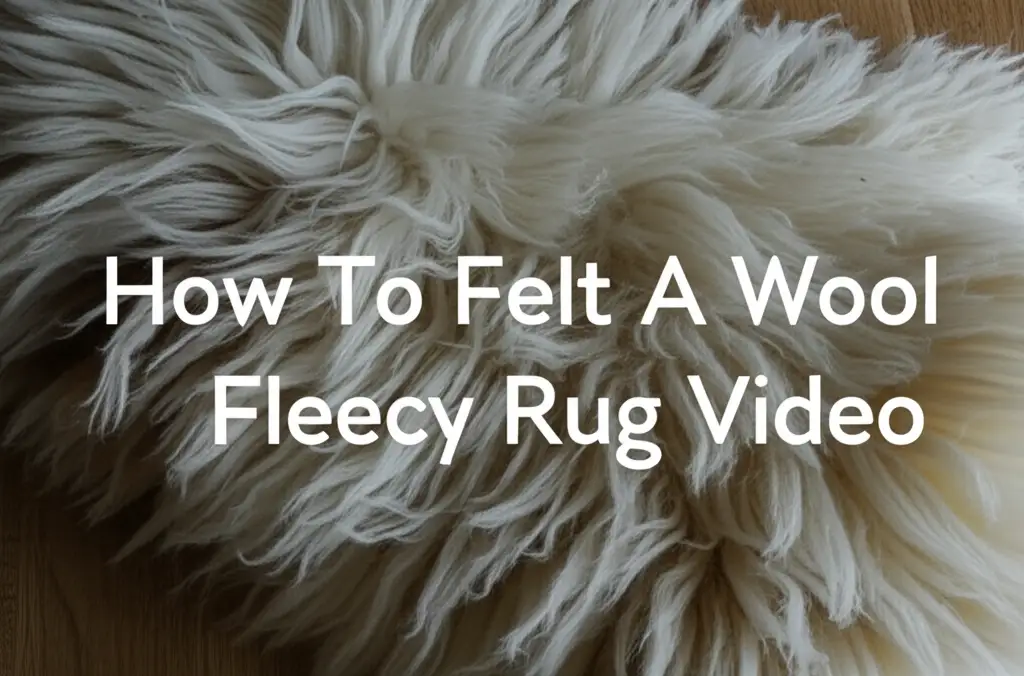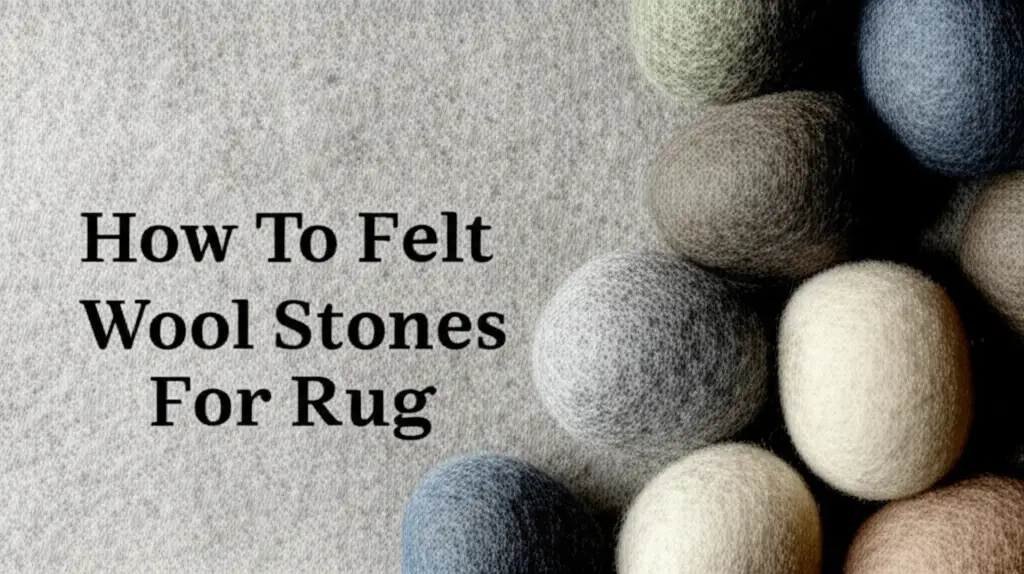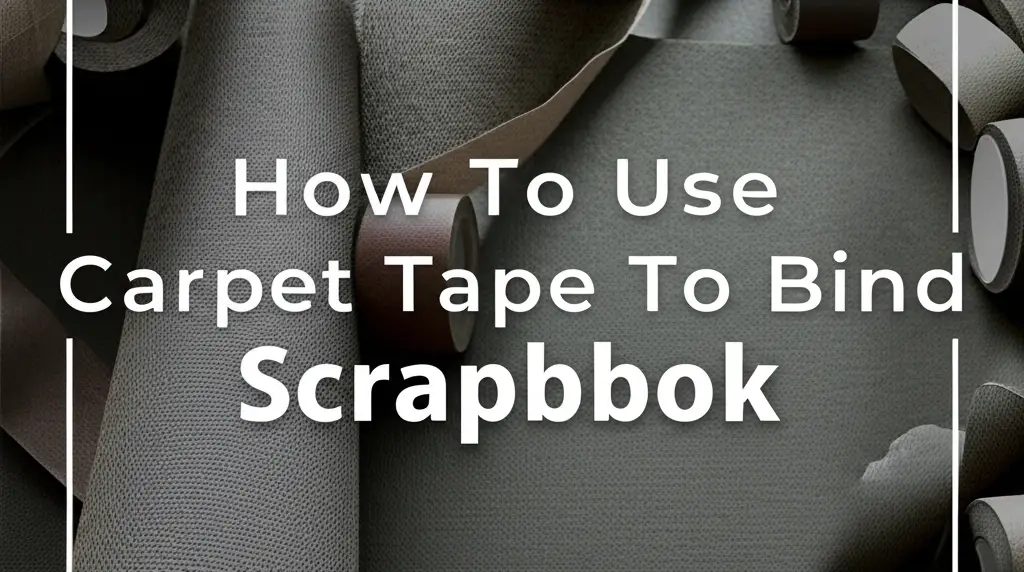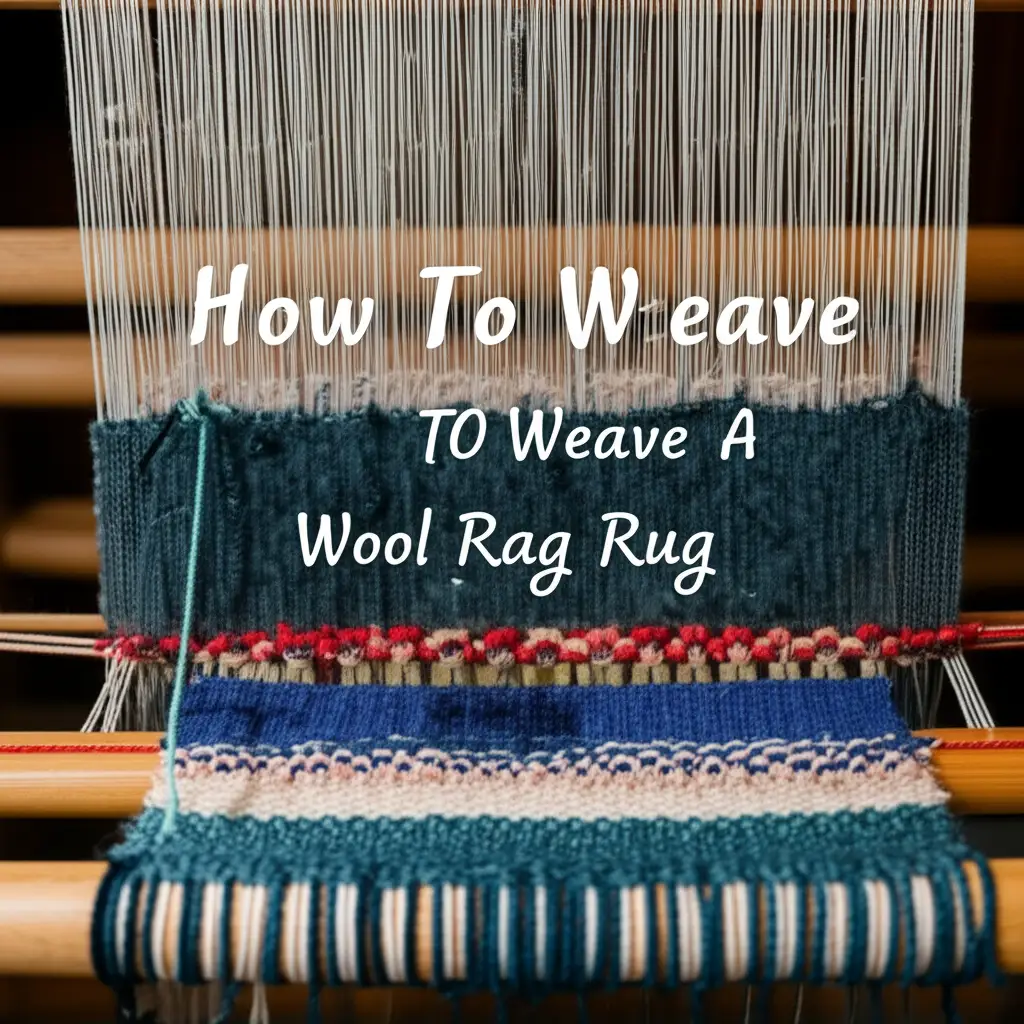· Tessa Winslow · DIY Crafts · 16 min read
How To Felt A Wool Fleecy Rug Video

Felt a Wool Fleecy Rug: Your DIY Video Guide
Imagine stepping onto a soft, warm rug you made yourself. It feels good, right? Creating a cozy wool fleecy rug is a rewarding project. Many people want to learn this skill. It brings natural beauty and comfort into your home. This guide shares how to felt a wool fleecy rug, just like a detailed video tutorial would.
We will explore the art of wet felting, from gathering your wool to caring for the finished rug. You will learn about the right materials and tools. We will go through each step, making the process simple. My goal is to help you create a beautiful, durable wool rug. Get ready to transform raw wool into a treasured home item.
Takeaway
- Gather all necessary materials before starting your felting project.
- Understand the importance of laying wool evenly for a consistent rug.
- Master the wet felting technique through gentle agitation and fulling.
- Ensure proper rinsing and drying to maintain the rug’s shape and quality.
- Learn how to care for your handmade felted rug for lasting beauty.
Felt a wool fleecy rug by layering wool fibers, wetting them with soapy water, and agitating them until they interlock. This process, called wet felting, creates a dense, durable fabric. You then rinse, shape, and dry the rug to finish your handmade creation.
Understanding Wool Felting for Rugs
Felting is an ancient craft. It turns loose wool fibers into a solid fabric. Wool fibers have scales. These scales interlock when wet and agitated. This creates a strong, dense material. People use this method to make many things, including rugs. It is a simple yet powerful transformation.
There are two main types of felting: wet felting and needle felting. For a wool fleecy rug, wet felting is the primary method. Wet felting uses water, soap, and friction. It makes a sturdy fabric. Needle felting uses barbed needles. It pokes fibers together. You might use needle felting for small details on a wet-felted base. For a whole rug, wet felting is more efficient and creates a more cohesive piece.
Wool is perfect for rugs because of its natural properties. It is durable. It resists dirt and stains. Wool also offers excellent insulation, keeping your feet warm. When felted, wool rugs become very strong. They can last for many years with good care. These natural fibers make wool a great choice for home decor.
Different types of wool work well for felting. Raw fleece from a sheep is excellent if you can process it. Roving, which is wool combed into long strands, is also perfect. Merino wool is soft, but a coarser wool like Corriedale or Shetland might be better for rugs. These provide more bulk and strength. I believe starting with quality wool makes a big difference in the final product. It helps to understand that some wools felt easier than others. This knowledge helps you choose the best wool for your rug project. For more on similar techniques, you can explore how to felt wool stones for rug.
Gathering Your Felting Materials and Tools
Before you start felting, you need the right supplies. Having everything ready makes the process smooth. You do not want to stop in the middle of your project. My goal is to make sure you have a complete list. This way, you can focus on the craft.
First, you need wool. The amount depends on your rug size. For a small rug (about 2x3 feet), plan for 1 to 2 pounds of wool roving or washed fleece. If you want a very fleecy look, use raw, un-carded locks of wool. These give the rug its unique texture. I suggest choosing wool that is clean and free of vegetable matter.
Next, you need soap. Liquid olive oil soap or dish soap works well. It helps the wool fibers slide and then lock together. Do not use detergent with harsh chemicals. These can damage the wool. You also need warm water. A spray bottle helps apply water evenly. A larger container, like a bucket, holds extra water.
For tools, you need a sturdy work surface. A table covered with a plastic sheet works. You also need bubble wrap. The bubbles create friction, which helps with felting. A large piece of fine netting or sheer fabric is useful. It holds the wool in place during agitation. A pool noodle or PVC pipe can be used for rolling. Heavy-duty garbage bags or a large plastic tarp are good for wrapping your project. Towels are essential for absorbing excess water.
- Essential Materials:
- Wool (roving, batts, or washed fleece/locks)
- Liquid soap (olive oil soap or mild dish soap)
- Warm water
- Bubble wrap (large piece)
- Fine netting or sheer fabric
- Pool noodle or PVC pipe (for rolling)
- Large plastic sheet or tarp
- Towels
- Sharp scissors (for trimming)
Having these felting supplies ready ensures a smooth start. My experience tells me that preparation is key to a successful project. You will feel more confident moving to the next steps. This setup makes the DIY rug creation much simpler.
Preparing Your Wool Fleece for Felting
Getting your wool ready is a crucial step. How you prepare the wool affects the final look and feel of your rug. This is where the “fleecy” part of your rug really comes to life. It also determines how strong and even your felted rug will be. I always take my time with this stage.
If you are using raw wool fleece, you might need to wash it first. Raw fleece often contains dirt, lanolin, and vegetable matter. You can wash it gently with warm water and a little wool wash. Rinse it well and let it dry. If you use wool roving or batts, they are usually pre-cleaned. This saves you a step.
The key to a fleecy rug is how you lay out the wool. Start by laying your plastic sheet or tarp on your work surface. Then, place a layer of bubble wrap on top, bubble side up. This provides the texture for felting. Now, begin laying out your wool. You want to create a flat, even layer.
You will lay the wool in multiple thin layers. Each layer should crisscross the previous one. For example, lay the first layer vertically, the second horizontally, the third diagonally. This crosshatch pattern is important. It helps the fibers interlock in all directions. This makes the felt strong and prevents weak spots. Think about the size and shape of your rug as you lay it out. Add an extra 20-30% to your desired final size. Wool shrinks during felting.
For the fleecy texture, you will add wool locks on top. These are un-carded, curly pieces of wool. Lay them loosely on the top layer. Do not flatten them too much. These locks will felt into the base, but their ends will remain soft and fluffy. This creates the unique fleecy appearance. My tip is to make sure your base layer is thick enough. This supports the fleecy top. A good base makes the rug durable.
The Wet Felting Process: Step-by-Step Guide
Now for the magic: the wet felting process. This is where the wool fibers transform. It is exciting to see the change. This method needs patience and consistent effort. I will guide you through each stage clearly.
1. Wetting the Wool: Once your wool layers are perfectly arranged, it is time to add water and soap. Gently spray warm water over the entire surface of the wool. You want the wool to be thoroughly wet, but not soaking. Too much water will wash away the soap. Next, drizzle a small amount of liquid soap evenly over the wet wool. The soap helps the fibers move against each other. It also helps them bond.
2. Covering and Initial Pressing: Carefully place your fine netting or sheer fabric over the wet, soapy wool. This netting prevents the wool from shifting too much during agitation. It also helps to apply pressure evenly. Gently press down on the netting with your hands. This pushes the water and soap deeper into the wool layers. You should see bubbles forming. This step also helps remove air pockets.
3. Agitation: The Heart of Felting: This is the most active part of the process. You need to rub the wool to make the fibers interlock. Start with gentle rubbing motions over the netting. Use your flat hands. Move in small circles. Gradually increase the pressure and speed as the wool starts to felt. You will feel the wool firming up. This is a good sign. Work on all areas of the rug evenly. Pay attention to the edges; they often need more work.
For larger rugs, rolling is more efficient. Once the wool has slightly felted and formed a fragile fabric, you can remove the netting. Carefully roll up the bubble wrap with the wool inside. Use your pool noodle or PVC pipe as a core. Secure the roll with string or elastic bands. Roll the bundle back and forth on your work surface. Roll in different directions to ensure even felting. Stop periodically to unroll and check your progress. You will feel the wool getting denser and shrinking. This shrinking is part of the felting process. Keep rolling and rubbing until the rug feels like a solid piece of fabric. It should no longer pull apart easily. I find this stage the most satisfying.
Fulling and Finishing Your Wool Rug
After the initial felting, your rug will be a loose, flimsy fabric. Now, you need to full it. Fulling is an important step. It shrinks the felt further. It also makes the fabric very strong and dense. It makes your rug durable. I think this stage truly brings the rug to life.
To full your rug, you will continue to agitate it. The goal is to apply more vigorous action. You can gently toss, roll, or even lightly throw the felt onto your work surface. The impact helps the fibers shrink and tighten. Some people use their feet to walk on larger rugs. This also creates the necessary friction. You will notice the rug getting smaller and thicker. It will become much firmer. Continue fulling until the rug reaches your desired density and size. My advice is to stop just before it gets too stiff. You want it firm but still soft.
Once the rug is fully felted, it is time to rinse out all the soap. Take your rug to a sink or bathtub. Rinse it with warm water first, then gradually switch to cooler water. Keep rinsing until the water runs clear and no more soap bubbles appear. This step is crucial. Any soap left in the rug can attract dirt later. I often press the rug between my hands to squeeze out soapy water.
After rinsing, you need to remove excess water. You can gently press the rug or roll it tightly in a clean towel. This absorbs a lot of water. Do not wring or twist the rug harshly. This can distort its shape. Now, it is time to shape your rug. Lay it flat on a clean surface. Gently pull and push the edges to achieve your desired shape. If it is rectangular, make sure the corners are square.
Finally, dry your rug. Lay it flat in a well-ventilated area. Direct sunlight or a clothesline can work, but avoid extreme heat, which can over-shrink the wool. Turning the rug periodically helps it dry evenly. Drying can take several days, depending on the rug’s thickness and humidity. Once dry, your handmade felted rug is ready to use. I love seeing the finished product after all the hard work.
Tips for a Beautiful and Durable Felted Rug
Creating a felted rug is a creative journey. To ensure your rug is not just beautiful but also lasts, some tips help. These tips come from experience. They address common challenges. I believe these insights will make your felting project even better.
1. Even Wool Layers: The most critical tip is to lay your wool evenly. If one area is too thin, it will felt faster or create a weak spot. If an area is too thick, it might not felt properly. Take your time during the layering phase. My technique is to check for light spots by holding the layered wool up to a window.
2. Consistent Agitation: Apply even pressure when agitating. Some people rub harder in one spot than another. This leads to uneven felting. Use your whole hand or arm to spread the friction. For rolling, ensure the roll is tight and even. Change the direction of rolling often. This helps all fibers interlock.
3. Test for Fulling: How do you know when your rug is fully felted? A simple test is the “pinch test.” Pinch a small part of the felt between your thumb and forefinger. If you can still easily pull apart individual fibers, it needs more fulling. If the fibers hold together as a solid fabric, you are good. My general rule is to aim for a firm, dense feel, not a soft, loose one.
4. Adding Design and Color: Do not be afraid to add color. You can lay different colored wool roving in patterns on your base layer. These colors will felt into the rug. For a “fleecy” look, use natural undyed wool locks on top. You can also add small felted elements, like circles or strips, before the final fulling. These will integrate into the rug.
5. Troubleshooting Thin Spots: If you find a thin spot during felting, it is often fixable. Gently lift the netting. Add a few loose fibers of wool over the thin area. Re-wet it with soapy water. Then, resume gentle agitation. The new fibers should felt into the existing fabric. I have fixed many small mistakes this way. Remember, practice makes perfect. Your first rug might not be flawless. Each project helps you learn more.
Caring for Your Handmade Fleecy Wool Rug
You put effort into making your wool fleecy rug. Now, you want it to last. Proper care is essential for any handmade textile. Wool is durable, but it needs specific cleaning methods. I want to ensure your beautiful creation stays beautiful for years.
1. Regular Cleaning: For routine cleaning, vacuum your felted rug gently. Use a low suction setting. Avoid beater bars, as they can pull out wool fibers. Vacuuming regularly removes dust and loose dirt. This prevents dirt from settling deep into the fibers. You can also take your rug outside and shake it gently. This helps dislodge any trapped debris.
2. Spot Cleaning: Accidents happen. For spills, act quickly. Blot the spill with a clean, dry cloth. Do not rub, as this can spread the stain. For liquid stains, use a mild wool-safe soap. Mix a tiny amount with cool water. Apply it to the stain with a clean cloth. Blot gently. Rinse the area by blotting with a damp cloth until no soap remains. Then, blot dry. Always test any cleaning solution on an inconspicuous spot first. My experience suggests that quick action saves many stains. For general guidance on rug cleaning, you can refer to how to clean a rug by hand.
3. Deep Cleaning: For a deeper clean, you can hand wash your felted wool rug. Fill a tub with lukewarm water and a small amount of wool wash. Submerge the rug. Gently squeeze and press the rug to clean it. Do not agitate too much, or it will felt further. Rinse thoroughly with cool water until all soap is gone. Press out excess water and lay flat to dry. Do not put it in a washing machine or dryer. This will cause irreversible shrinkage and damage. You can find more tips on how to care for similar items by checking out how do you clean an area wool rug or how to clean a handwoven wool rug.
4. Pest Prevention: Wool rugs can attract moths. Store your rug in a cool, dry place if not in use. Use cedar blocks or lavender sachets as natural repellents. Regularly vacuuming and exposing the rug to light can also deter pests. If you notice signs of moths, act immediately. Information on this is available in how to get rid of months in wool rugs. Proper care extends the life of your rug. It keeps it looking its best.
FAQ Section
Q: How long does it take to felt a wool fleecy rug? A: The time varies greatly. A small rug, like 2x3 feet, might take 4-6 hours of active felting. Larger rugs can take 8-12 hours or more. The preparation, drying, and planning time adds to the total. My advice is to break the project into multiple sessions if needed.
Q: Can I use different types of wool for felting? A: Yes, you can. Different wools have different felting qualities. Merino wool is very soft and felts quickly. Coarser wools like Corriedale or Romney are excellent for durable rugs. They shrink more and create a denser felt. You can also blend different wool types for unique textures.
Q: Is felting a wool rug difficult for beginners? A: Not at all. Felting a wool rug is a beginner-friendly craft. It requires patience and physical effort, but the techniques are simple. My recommendation is to start with a smaller rug. This lets you learn the process without feeling overwhelmed. Watch videos and read guides for confidence.
Q: How do I make my felted rug truly fleecy? A: To achieve a fleecy look, use un-carded wool locks for the top layer. Lay these locks loosely on your base wool before wetting. The ends of these locks will remain free and fluffy after felting. This creates the signature fleecy texture. Do not press them too hard during the initial stages.
Q: What if my felted rug is too thin in some areas? A: If you notice thin spots during felting, you can often fix them. Gently lift the netting and place a few extra wool fibers over the thin area. Re-wet with soapy water and gently agitate. The new fibers should felt into the existing fabric. It takes a little more careful work.
Q: How do I clean a felted wool rug? A: For routine cleaning, vacuum gently without a beater bar. For spills, blot immediately with a clean cloth. For a deeper clean, hand wash the rug in a tub with lukewarm water and wool-safe soap. Rinse thoroughly and lay flat to dry. Do not machine wash or dry.
Conclusion
Creating your own wool fleecy rug is a truly rewarding experience. From selecting the softest wool to seeing the fibers transform, each step brings you closer to a beautiful, handmade piece. You have learned how to felt a wool fleecy rug, understanding the materials, the process, and how to care for your new treasure. This art form connects you with natural materials and offers a unique way to personalize your home. My hope is that this guide inspires you.
Imagine the satisfaction of stepping onto a warm rug you crafted yourself. It is more than just a rug; it is a piece of your creativity. The durability and natural beauty of felted wool will bring comfort for years. Do not hesitate to start your felting journey. Gather your wool, prepare your space, and begin the enjoyable process. I encourage you to embrace this craft and discover the joy of making. Your home will thank you for it.





